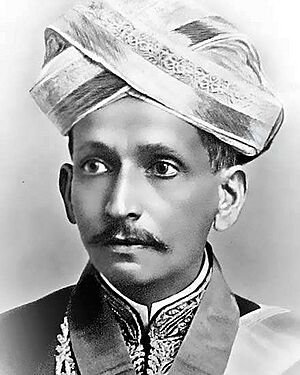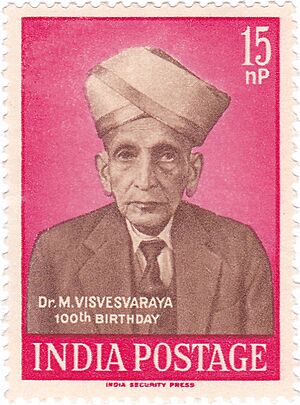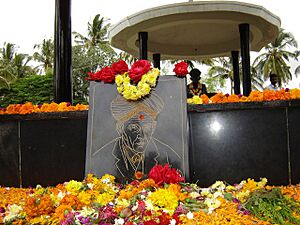M. Visvesvaraya facts for kids
Quick facts for kids
M. Visvesvaraya
KCIE, FASc
|
|
|---|---|

Visvesvaraya in his 40s
|
|
| 19th Dewan of Mysore | |
| In office 1912–1918 |
|
| Monarch | Krishna Raja Wadiyar IV |
| Preceded by | T. Ananda Rao |
| Succeeded by | M. Kantaraj Urs |
| Personal details | |
| Born |
Mokshagundam Visvesvaraya
15 September 1861 Muddenahalli, Kingdom of Mysore, British India |
| Died | 12/14 April 1962 (aged 100) Bangalore, Mysore State, India (present-day Karnataka, India) |
| Nationality | British India (1861-1947) India (1947-1962) |
| Alma mater |
|
| Profession | Civil engineer and statesman |
| Awards | Bharat Ratna (1955) |
Sir Mokshagundam Visvesvaraya (born September 15, 1861 – died April 12/14, 1962), often called MV, was a brilliant Indian civil engineer. He was also a great administrator and a leader. He served as the 19th Dewan of Mysore from 1912 to 1918. A Dewan was like a prime minister or chief minister of a princely state in India.
Many people in India see Visvesvaraya as one of the best civil engineers ever. His birthday, September 15, is celebrated every year as Engineer's Day in India. This day is also celebrated in Sri Lanka and Tanzania. He is often called "the maker of modern Mysore". He is also a very popular person in the southern Indian state of Karnataka.
Visvesvaraya worked as an engineer for the government of British India. Later, he became the chief minister of the Kingdom of Mysore. For his amazing work, he received many honors. He was knighted by the British King. After India became independent, he received the Bharat Ratna in 1955. This is India's highest award for civilians.
Contents
Early Life and Education
M. Visvesvaraya was born on September 15, 1861. His birthplace was Muddenahalli in the Kingdom of Mysore. This area is now part of Chikkaballapura district, Karnataka. His family spoke Telugu. His parents were Mokshagundam Srinivasa Shastry and Venkatalakshmi. His family had moved to Mysore from Andhra Pradesh many years before he was born.
Visvesvaraya started his education in Bangalore. He earned a Bachelor of Science (BSc) degree from the University of Madras. He then went to the College of Engineering, Pune. This college was part of the University of Bombay at that time. He graduated as an engineer with a Diploma in Civil Engineering.
A Career in Engineering and Leadership
Visvesvaraya started his career working for the Government of British India. He worked in places like the Bombay Presidency and other British areas in the Middle East. Later, he worked for the Hyderabad State. After retiring from British service, he continued his engineering work. He also took on leadership roles in the Kingdom of Mysore.
Engineering Achievements
Visvesvaraya became an assistant engineer in 1885. He worked in the Public Works Department in Bombay.
In 1899, he joined the Indian Irrigation Commission. Here, he created a complex irrigation system in the Deccan Plateau. He also designed and patented special automatic floodgates. These gates were first used in 1903 at Khadakwasla Dam near Pune. These gates helped store more water in the reservoir. They did this without harming the dam. This successful system was later used at Tigra Dam in Gwalior. It was also installed at the famous KRS Dam near Mysore. He also became the chief engineer of the Laxmi Talav Dam near Kolhapur.
Around 1906, the British Indian government sent Visvesvaraya to Aden Colony (now Yemen). He went there to study water supply and drainage systems. His plans were successfully put into action in Aden.
After retiring in 1908, Visvesvaraya traveled to study industrial countries. For a short time, he worked for Nizam Mir Osman Ali Khan of Hyderabad. He was one of the main engineers for Hyderabad's flood protection. He suggested ways to protect the city from the Musi river, which often caused floods. He became very famous for designing this flood protection system. He also helped protect Visakhapatnam port from sea erosion. The dam he designed created the largest reservoir in Asia at that time.
In November 1909, he became the chief engineer of Mysore State. He was invited by Dewan V. P. Madhava Rao. He was the Chief Engineer for the KRS Dam in Mysore. He also led the team of engineers for the Tungabhadra Dam in Hospet, Karnataka.
Leading the Kingdom of Mysore
In 1912, Maharaja Krishna Raja Wadiyar IV appointed Visvesvaraya as the Dewan of Mysore. He served in this important role for almost seven years, until 1918. With the Maharaja's support, Visvesvaraya helped develop the Kingdom of Mysore in many ways.
During his time as Dewan, Visvesvaraya helped start many factories and institutions. These were funded by the Maharaja. Some examples include:
- Mysore Soap Factory
- Mysore Iron & Steel Works in Bhadravathi
- Bangalore Polytechnic (now Sri Jayachamarajendra Polytechnic Bangalore)
- Bangalore Agricultural University
- State Bank of Mysore
- Mysore Chamber of Commerce (now Federation of Karnataka Chambers of Commerce & Industry)
He also helped establish The Bangalore Press. In 1917, he was key in founding the Government Engineering College in Bangalore. This was one of India's first engineering schools. He also helped build several new railway lines in Mysore Railways.
Visvesvaraya encouraged private businesses to invest in industries. He also planned the construction of a road between Tirumala and Tirupati. Even when he was over 90 years old, he gave technical advice. He helped choose the location for the Mokama Bridge over the Ganga River in Bihar.
Awards and Special Honors
Visvesvaraya received many honors for his public service. In 1911, King Edward VII made him a Companion of the Order of the Indian Empire (CIE). In 1915, King George V knighted him as a Knight Commander of the Order of the Indian Empire (KCIE). This is why he is called "Sir."
After India became independent, Visvesvaraya received the Bharat Ratna in 1955. This is India's highest civilian award. He also received honorary memberships from the Institution of Civil Engineers, London. He was also a fellow at the Indian Institute of Science, Bangalore. Many universities in India gave him honorary degrees, like Doctor of Science (D.Sc.). He was also the president of the Indian Science Congress in 1923.
Lasting Recognition
Many institutions are named after Visvesvaraya to honor his contributions.
- Visvesvaraya Technological University in Belagavi, which most engineering colleges in Karnataka are part of.
- University Visvesvaraya College of Engineering, Bangalore.
- Sir M. Visvesvaraya Institute of Technology, Bangalore.
- Visvesvaraya National Institute of Technology, Nagpur.
- Visvesvaraya Hostel at IIT (BHU) Varanasi.
- Visvesvaraya Industrial and Technological Museum, Bangalore.
His alma mater, the College of Engineering, Pune, has a statue of him. Two metro stations in India are named after him:
The railway terminal in Baiyyapanahalli at Bangalore is also named Sir M. Visvesvaraya Terminal after him.
On September 15, 2018, Google honored him with a Google Doodle to celebrate his 157th birthday.
Later Years and Legacy
Visvesvaraya passed away on April 12 or 14, 1962. He lived to be 100 years old.
He was known for being very sincere and dedicated to his work. He was also very good at managing his time. Visvesvaraya was a strict vegetarian.
He had a great love for the Kannada language. He started the Kannada Parishat to help improve the language. He wanted seminars for Kannada supporters to be held in Kannada itself.
Memorial at Muddenahalli
The Visvesvaraya National Memorial Trust manages a memorial for him. It is located at his birthplace in Muddenahalli. The memorial displays his awards, titles, and personal items. These include his living room, spectacles, cups, and books. Models of the Krishna Raja Sagar Dam, which he designed, are also on display. The memorial is next to his house, which has been restored. Local people consider it a special place.
Images for kids
See also
 In Spanish: M. Visvesvaraya para niños
In Spanish: M. Visvesvaraya para niños






